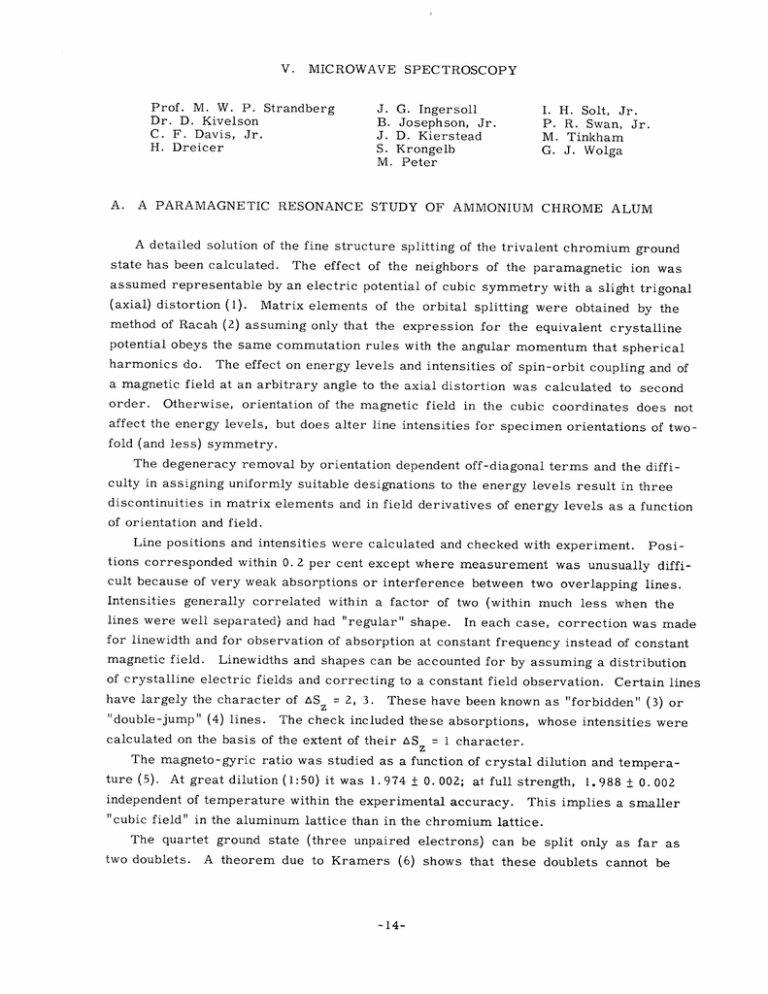V. MICROWAVE SPECTROSCOPY J. G. Ingersoll
advertisement

V. MICROWAVE Prof. M. W. P. Strandberg Dr. D. Kivelson C. F. Davis, Jr. H. Dreicer A. A PARAMAGNETIC J. B. J. S. M. SPECTROSCOPY G. Ingersoll Josephson, Jr. D. Kierstead Krongelb Peter I. H. Solt, Jr. P. R. Swan, Jr. M. Tinkham G. J. Wolga RESONANCE STUDY OF AMMONIUM CHROME ALUM A detailed solution of the fine structure splitting of the trivalent chromium ground state has been calculated. The effect of the neighbors of the paramagnetic ion was assumed representable by an electric potential of cubic symmetry with a slight trigonal (axial) distortion (1). Matrix elements of the orbital splitting were obtained by the method of Racah (2) assuming only that the expression for the equivalent crystalline potential obeys the same commutation rules with the angular momentum that spherical harmonics do. The effect on energy levels and intensities of spin-orbit coupling and of a magnetic field at an arbitrary angle to the axial distortion was calculated to second order. Otherwise, orientation of the magnetic field in the cubic coordinates does not affect the energy levels, but does alter line intensities for specimen orientations of twofold (and less) symmetry. The degeneracy removal by orientation dependent off-diagonal terms and the difficulty in assigning uniformly suitable designations to the energy levels result in three discontinuities in matrix elements and in field derivatives of energy levels as a function of orientation and field. Line positions and intensities were calculated and checked with experiment. Positions corresponded within 0. 2 per cent except where measurement was unusually difficult because of very weak absorptions or interference between two overlapping lines. Intensities generally correlated within a factor of two (within much less when the lines were well separated) and had "regular" shape. In each case, correction was made for linewidth and for observation of absorption at constant frequency instead of constant magnetic field. Linewidths and shapes can be accounted for by assuming a distribution of crystalline electric fields and correcting to a constant field observation. have largely the character of ASz = 2, 3. "double-jump" (4) lines. Certain lines These have been known as "forbidden" (3) The check included these absorptions, or whose intensities were calculated on the basis of the extent of their AS = 1 character. z The magneto-gyric ratio was studied as a function of crystal dilution and temperature (5). At great dilution (1:50) it was 1.974 ± 0. 002; at full strength, 1.988 ± 0. 002 independent of temperature within the experimental accuracy. This implies a smaller "cubic field" in the aluminum lattice than in the chromium lattice. The quartet ground state (three unpaired electrons) can be split only as far as two doublets. A theorem due to Kramers (6) shows that these doublets cannot be -14- (V. MICROWAVE SPECTROSCOPY) decomposed by an electric field. The separation of these energy levels (zero field -i splitting, 6) can easily be measured experimentally and amounts to 0. 098 cm- for the -l very dilute material, 0. 135 cm-1 for full strength, at 25 0 C. These values decrease at about the rate of 0. 0005 cm- /oK to 80 0 K (7). This implies a strong decrease in axial distortion with lower temperature. At about 80 0 K, the full strength alum and alums of low dilution undergo a secondorder phase transition. Characteristics of this transition have been studied elsewhere in optical, thermodynamic, and other paramagnetic resonance work (8, 9, 10). x-ray diffraction patterns were compared above and below the transition. Powder Line spacing was identical within the resolution of the lines, but intensities changed somewhat. heavier atoms undoubtedly do not change position appreciably. The Below the transition two microwave splittings have been observed which can only be accounted for by the existence of the chromium ions in two possible environments. The magnet, microwave, control, and presentation apparatus used in this research will be described in two forthcoming Review of Scientific Instruments articles. This problem has been the subject of a thesis submitted to the M. I. T. Department of Physics. C. F. Davis, Jr. References H. van Vleck, Phys. Rev. 41, 208 (1932). 1. J. 2. G. Racah, Phys. Rev. 62, 438 (1942). 3. R. Malvano and M. Panetti, Phys. 4. J. 5. Quarterly Progress Report, Research Laboratory of Electronics, 1954, p. 19. 6. H. A. Kramers, Amsterdam K. Akad. Wetenschapen 33, Am. J. Phys. 20, 65 (,1952). 7. D. Ubbink, J. M. S. A. Poulis, and C. Bagguley and J. H. E. J. Rev. 78, 826 L (1950). Gorter, Physica 17, 213 (1951). Griffiths, Proc. Roy. M. I. T., 959 (1930); Soc. Jan. 15, M. J. (London) Klein, 204A, 188 (1950). L. Kraus and G. C. Nutting, J. 8. D. 9. H. L. Johnston, (1953). 10. B. Jih-Heng Hu, B. Bleaney, Proc. Roy. Soc. Chem. Phys. 9, and W. S. Horton, 133 (1941). J. Am. Chem. Soc. 75, 3922 (London) 204A, 203 (1950). HINDERED ROTATION IN SEMISYMMETRIC MOLECULES A molecule which may be described as a semisymmetric hindered rotor is one that consists of a symmetric top attached at an arbitrary angle to a general asymmetric framework, and allowed to rotate about its symmetry axis relative to the frame. -15- (V. MICROWAVE SPECTROSCOPY) A well-known example of this type of molecule is methyl alcohol, CH 3 -OH. If the two groups are taken as rigid, then the microwave spectrum will be due to the interaction of hindered rotation with over-all rotation. A theory is being developed for this general type of molecule which will give the Hamiltonian in terms of principal moments of the molecule and the angle of the top relative to principal axes. The pure hindered-rotation spectrum will then be calculated and compared to the experimental results for sample molecules. P. -16- R. Swan, Jr.


